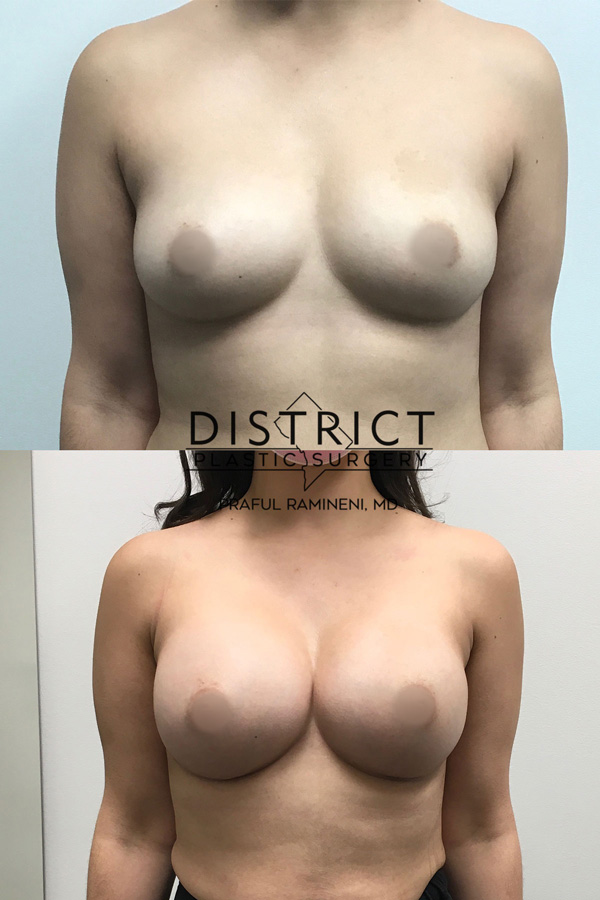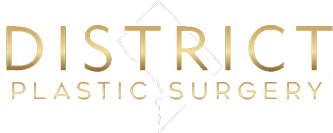
Breast Augmentation with Implants
Conveniently located to serve Washington DC, Arlington, Bethesda
JUMP TO:
What is Breast Augmentation?
Breast Augmentation is a surgery that increases the size of your breasts using either saline or silicone breast implants to increase the size of your breasts. Surgery takes under an hour and recovery is quick. Most patients are back to work within a few days to a week and back to the gym in a few weeks. The surgery has a very high satisfaction rate which contributes to its popularity.
How is the procedure performed?
Depending on the procedure plan, the breast augmentation procedure lasts 1 to 2 hours. First, the patient is administered anesthesia to make the procedure comfortable.
A small incision is made, either under the breast, at the areolar border, or through the armpit. Second, a space is created either under or over the muscle to accommodate the implant. Next, the implant is placed with a device called a Keller funnel after irrigating the pocket with antibiotic solution. Then the incisions are meticulously closed, the incisions dressed and you are placed in a supportive post-surgical bra.
Who gets Breast Augmentation?
Breast augmentation is a great procedure for anyone who is unhappy with the current size of their breasts. This can be done prior to having any planned children or after childbirth/breast feeding if your breasts are looking deflated. Breastfeeding is still possible after surgery.
Healthy patients with no post-surgery healing issues are the best candidates for breast augmentation with implants. Breast augmentation is perfect for patients who are not satisfied with their breast size or symmetry.
Candidates must have realistic aesthetic goals, and non-smokers are preferred. If you are a smoker, you will need to quit before the procedure date.

Recovery
The condition of the patient will be monitored for some time before being released. A small drain may be inserted to prevent fluid buildup during the recovery period. Prescriptions and recovery instructions will be given.
During the first few days of the healing process, the patient will experience a degree of swelling, bruising, and discomfort.
Recovery is fairly easy with most patients returning to work within a few days to a week.
Showering resumes 72 hours after surgery. Exercise resumes at 2-3 weeks and you can start using a pool at the 4-week mark. A surgical bra or a sports bra is worn for the first month and we recommend waiting 6 weeks to purchase new bras/swimsuits to allow swelling to subside.
Physical activities will be limited for the first week, and strenuous activities will be prohibited until allowed by the surgeon. A follow-up visit will be scheduled to monitor the patient’s recovery process.
How Much Does Breast Augmentation Implants Cost?
The cost of a Breast Augmentation Implants varies, because it is a highly individualized surgery tailored for each patient. The overall price may include anesthesia, operating room facilities, new breast implants, and other related expenses. Additional tests and imaging may also add to your total. Contact us for additional information
Consultation
At your consultation, Dr. Ramineni will obtain your health history including reasons for having the surgery. We will show you implants and work with you on sizing to get a range of what size you would like by having you try on implants. We will finalize implant size at a second visit in some cases. We will also discuss and review several choices and make recommendations about surgical specifics including:
- Saline or Silicone
- Over or Under the muscle or subfascial placement
- Do I need a lift?
- Where to place the incision
The vast majority of patients have silicone implants placed. They tend to feel/look more natural and can have increased longevity. The implants placed are cohesive gel (gummy bear) implants that won’t leak even if they were cut in half! Dr. Ramineni prefers to use the higher-end implants for optimal results – they are the same implants that he has used in his staff members’ surgeries and even in his own wife’s surgery.
Dr. Ramineni performs both over and under the muscle placement and subfacial placement, depending on how much preexisting breast tissue you have. In the past, almost all implants were placed under the muscle (submuscular) to try to get a more natural result. Improvements in implant technology, have now allowed the majority of the implants to be able to be placed above the muscle with excellent results. Over the muscle, implants work well for patients that have some preexisting breast tissue. The implant is placed either just under the breast (subglandular) or under the thin layer covering the muscle called the fascia (subfascial). This decreases pain significantly allowing most patients to have the surgery on a Friday and be back to work Monday. This also avoids animation deformity which is when the implant moves when the pectoralis muscle contracts. This also minimizes the risk of “waterfall deformity” as you age. This is when the breasts start to sag over time, but the implant continues to sit higher on the chest wall, leading to the appearance that the breast is sliding down on top of the implant. This would require future surgery to improve the appearance. Over the muscle implants tend to age with the breast as a unit. Under the muscle, implants are good for patients with minimal preexisting breast tissue to create a more natural look to the upper pole of the breast. This creates a more gentle slope if there is not enough breast to hide the transition. One important thing to note is that the pectoralis muscle “windowshades” up when it is used to cover the implant, so only the upper portion of the implant is covered by muscle. All submuscular implants are actually only partially submuscular, with the lower pole being under the breast tissue.
Some patients may require a breast lift at the same time as breast augmentation (augmentation mastopexy). The implant can fill in some of the lost volumes in weight loss or post-pregnancy, patients (like adding air to a balloon), however depending on how much extra skin there is and what size implants are chosen, there still be some sagging. If this is the case, a breast lift may be needed at the time of surgery. Depending on how much extra skin there is, there are different lifting techniques. This can sometimes be done through an incision along the upper part of the areola (crescent lift), around the entire areola (periareolar), around the areola with an incision running from the areola to the bottom of the breast (vertical lift/lollipop) or for patients with a large amount excess skin, an anchor/Weiss pattern lift may be needed. This combines the periareolar incision with a vertical incision and a horizontal incision that runs along the lowest part of the breast (inframammary fold).
Dr. Ramineni prides himself on making very small incisions (generally 3-4 cm). The implants is placed with a device called a Keller Funnel to deliver the implant through a very small incision with a no touch technique (the implant comes straight out of the sterile factory packaging, is dropped into the funnel and placed inside your breast without anybody touching the implant. This decreases the risk of implant hardness or infection. Depending on patient preference, the implants can be placed through an inframammary incision (at the fold), around the areola or through the armpit. The vast majority of patients prefer an incision at the fold under the breast since this allows the best positioning, better manipulation of the inframammary fold (if needed) and is well hidden. Incisions can also be made from the 3 to 9 o’clock position along the areolar border (periareolar), this avoids a lower breast incision, but does have a slightly higher risk of disruption to nipple sensation, breast feeding or capsular contracture. It is also possible to place the implant through the armpit (axillary incision) if you desire the least visible implant – this does have a slightly higher chance of implant displacement or hardness.
Breast Augmentation with Implant Risks
Implant rupture
In a low percentage of cases, an implant may wear out over time, this usually can’t be detected without an MRI in silicone implants since there are usually no symptoms (silent rupture). If a rupture is detected and there are no symptoms, some patients may just opt to keep the implant in, while other patients may decide to have the implant replaced. Most implant manufacturers have a warranty on the implant and will provide a new implant for the ruptured side and the other side at no charge – even if you decide to change sizes. Saline implants will generally deflate quickly and the non-toxic salt water will just be absorbed by your system.
Capsular contracture
When any implant is placed – whether it’s a breast implant, hip implant, surgical mesh, etc, your body will form a shell around the device. This is called a capsule. In the vast majority of cases, this is soft and you won’t ever notice it. In a few percent of cases, this shell can become hard causing a capsular contracture. This can cause suboptimal cosmesis or even pain. The cause of this is poorly understood, but is thought to be due to events that “irritate” the breast pocket – a subclinical infection, inflammatory conditions such as blood in the pocket, etc. If a higher grade capsular contracture happens, the treatment is to remove the capsule and to place a new implant. Generally most implant manufacturers will replace the implant at no cost if this happens.
Nerve changes
Some patients can experience a decrease or increase in nerve sensation to the nipple area, or even loss of sensation or pain. In most cases, nerve issues resolve by themselves by the 1 year mark.
Bleeding
Bleeding can happen after any surgery, and in rare cases, blood around an implant may need to be removed surgically. A follow-up appointment will allow the surgeon to monitor the breast for symptoms of bleeding.
Infection
Implant infections are exceedingly rare, however if an infection does occur and does not respond to antibiotics, the implant may need to be temporarily removed and replaced at a future date.
Implant rupture
Any medical device can fail over time, if this were to happen, usually the manufacturer will replace the implant free of charge and replace the non-damaged implant as well (even if you decide on a different size).
Assymetry
Virtually everyone has some minor differences between their breasts prior to surgery, during surgery we attempt to correct any preexisting asymmetries, however, very mild asymmetries may remain due to surgical limitations.
Need for revision
In some cases a touch up may be needed for optimal aesthetics.
Rippling
All implants have some degree of natural folding, in thin patients, this can sometimes be seen through the skin in certain positions.
Seroma
The fluid around the implant may need to be drained. This is usually prevented by inserting tiny drains right after the procedure to carry out excess fluid.
Mammographic changes
Extra views are needed on mammography to visualize the breast after augmentation. Radiologists are very familiar with these techniques to maximize the amount of breast tissue seen.
Scarring
There will be a small scar from the procedure, most patients have very fine line incisions, but in some patients who are genetically predisposed, a thicker scar may form and may need to be treated.
Unhappy with size
Although we spend a significant amount of time helping you choose your ultimate size, infrequently patients wish they went larger or smaller. In this unlikely event, a new implant can be placed with your desired size, most times under local anesthesia. We want you to be happy with your new breasts, so if this happens, we don’t charge any professional fees to change out the implants (you would just be responsible for the actual cost of the new implants and equipment fees).
Schedule a Consultation
Contact District Plastic Surgery today to schedule a consultation for your Breast Augmentation Implants in Washington. We will take the time to guide you through the entire process, ensuring results that fully satisfy your aesthetic needs. Contact us today!
Breast Implant Before & After Photos

Dr. Praful Ramineni
Plastic Surgeon in Washington D.C.
Dr. Ramineni is the founder of District Plastic Surgery. He is board certified and has over 20 years of experience in plastic and reconstructive surgery. He started his career as one of the busiest surgeons at Medstar Washington Hospital Center with a focus on complex reconstructive surgery including cancer and trauma reconstruction, microsurgery and aesthetic surgery.


Contact Us
